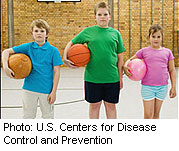- Double Mastectomy May Offer No Survival Benefit to Women With Breast Cancer
- Toxic Lead Found in Cinnamon Product, FDA Says
- Certain Abbott Blood Sugar Monitors May Give Incorrect Readings
- Athletes Can Expect High Ozone, Pollen Counts for Paris Olympics
- Fake Oxycontin Pills Widespread and Potentially Deadly: Report
- Shingles Vaccine Could Lower Dementia Risk
- Your Odds for Accidental Gun Death Rise Greatly in Certain States
- Kids From Poorer Families Less Likely to Survive Cancer
- Tough Workouts Won’t Trigger Cardiac Arrest in Folks With Long QT Syndrome
- At-Home Colon Cancer Test Can Save Lives
Will You Be Obese? Look at Your Sisters, Brothers


Obesity is known to run in families, but new research suggests this relationship may be the strongest among siblings.
Although older children in a two-child home with an obese parent are more than twice as likely to be obese, having an obese older sibling may raise the risk more than fivefold for a younger child, whether the parents are obese or not, the researchers reported.
“Siblings have a lot of influence,” said lead researcher Matthew Harding, an assistant professor in the Sanford School of Public Policy at Duke University in Durham, N.C.
“Children often model their behavior on that of their older siblings. Older siblings can have a strong influence on the attitudes and behaviors of younger siblings in relation to nutrition and exercise,” Harding noted.
Although parents play a big role in determining their children’s health, siblings may play an even greater role, he added.
For example, if the siblings are of the same sex, a boy with an obese older brother is 11 times more likely to be obese, Harding said.
“We need to recognize that children form strong bonds with their siblings, and when designing prevention or treatment of conditions such as obesity, we need to think carefully about the ties between siblings,” he said.
While the findings pointed to an association between obesity risk and siblings, they did not prove a cause-and-effect link between the two.
The report was published online July 8 and will appear in the October print issue of the American Journal of Preventive Medicine.
Dr. David Katz, director of the Yale University Prevention Research Center, was not involved with study but is familiar with the findings. He said, “My reaction to this study is partly as an obesity expert, but largely as a parent. My wife and I have five children, so I have firsthand knowledge of sibling interaction.”
Families share behaviors, values and dietary patterns, he said. “To some extent, this is a study showing that kids exposed to a set of familial patterns and priorities that protect against obesity will be less vulnerable and, of course, vice versa,” he added.
It’s also likely that siblings directly influence one another with regard to diet and activities. “Every parent of more than one child has seen this,” Katz said.
For the study, Harding’s team collected data on over 10,000 American households and found that childhood obesity risk varies with the number of children and their sex.
Specifically, the researchers found that in a single-child home where a parent is obese, the child is 2.2 times more likely to be obese. In families with two children, however, they found an even stronger link between siblings.
The study also found a link between gender and obesity risk. In homes with one child, girls were less likely to be obese than boys.
In homes with two children, Harding’s group found that younger kids are influenced by older siblings, especially if they’re same gender.
The youngest boy in a two-child home is 11.4 times more likely to be obese if the older brother is, they noted. If the older child is a girl, the boy is 6.6 times more likely to be obese.
If the youngest child is a girl, she is 8.6 times more likely to be obese if she has an obese older sister. But if she has an obese older brother she is not significantly more likely to be obese, the researchers found.
Exercise and how much the kids eat both play a key role in the prevention of obesity. Harding’s team found that an only child was less likely to be physically active and more likely to eat fast food than those who had brothers and sisters.
More information
Visit the U.S. Centers for Disease Control and Prevention for more on childhood obesity.
Source: HealthDay
Copyright © 2024 HealthDay. All rights reserved.










